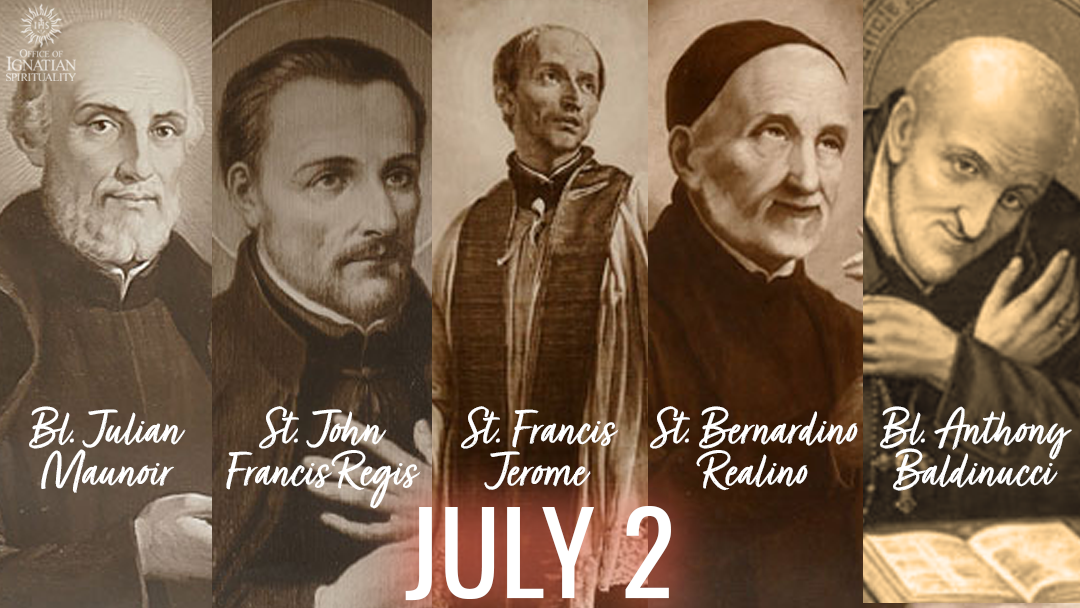July 2
Sts. Bernardino Realino, John Francis Regis, and Francis Jerome; Blesseds Julian Maunoir and Anthony Baldinucci
Memorial
Scripture Readings
Click here to find the daily readings for this day. [or see Common of Pastors or Common of Missionaries]
Reflection on Today’s Feast
By Fr. Kevin Spinale, SJ
The patronages that saints accrue are fascinating to me. Take St. John the Evangelist. Alphabetically, his patronages include: art dealers, authors, bookbinders, booksellers, burn victims, editors, engravers, friendships, lithographers, painters, papermakers, printers, publishers, tanners, theologians, typesetters, and writers. St. John the Baptist is the patron saint of baptism (of course), bird dealers, converts, epileptics, farriers, innkeepers, monastic life, motorways, printers, and tailors. St. Kateri Tekakwitha is patron saint of ecologists, the environment, exiles, those who have lost their parents as children, and – my favorite of Kateri’s patronages – people ridiculed for their piety. Such patronages give some insight into the biographies of saints and how men and women of faith understand their relationship with saints as companions and intercessors. Patronages are also filled with surprises.
St. John Francis Regis (1597-1640) is the patron saint of plague victims, social workers, lace makers, and embroiderers. The first two patronages make great sense. Regis tended to plague victims in Toulouse early on as a Jesuit, and he kept up the practice of visiting hospitals and ministering to plague victims throughout his life as a priest. His association with social workers also makes sense. He labored tirelessly, ceaselessly – and those two adverbs appear in most every biographical sketch of the saint – among the poor, among harvesters of hay, among rural peasants, among those who were forced to become prostitutes. In his eight years of priesthood, he sought to bring relief to the poor throughout southeast France. He relieved their burdens directly, and he heard their confessions with great generosity and gentleness. The rural poor adored him. All portraits of Regis emphasize this effect of his warmth as a minister of the Word. He was a domestic missionary who endeared himself to the men and women he served.
Yet, what about the lace? It is quite clear that St. John Francis Regis did not wear fancy clothes. He took his vow of poverty to the extreme – fasting continuously and exhausting himself in his priestly work. Some biographers attribute the patronage of lacemakers and embroiderers to his association with prostitutes and his commitment to housing prostitutes and teaching them skills like embroidery and lace work. Another biographical sketch cites a series of decrees made in the 1620’s and 1630’s that strictly regulated the lace industry in France, eliminating all filigree in the production of textiles. Then, in 1640, the French Crown prohibited any display of lace by anyone. The lacemaking industry – employing 40,000 workers – was to collapse. And so, lace workers in his native region of Languedoc appealed to Regis for help. While it is not known exactly what Regis did to broker a deal, the prohibition against lace was overturned, and the industry’s workers were soon back earning their livelihood. The lacemakers remained ever loyal to John Francis Regis, and they took him as their patron after his death.
St. John Francis Regis should be afforded one further patronage. Sts. Rose Philippine Duchesne, Madeleine Sophie Barat, and Thérèse Couderc saw it in him, as did St. John Vianney, who prayed at Regis’s tomb in Lalouvesc when he struggled through his own priestly formation. It is clear that St. John Francis Regis is a patron saint of Jesuit priestly ministry. Tireless, humble, mobile, concrete, thoughtful, gentle, pastoral priestly ministry underpinned by a life of lively personal prayer. Such prayer allowed him ever to be spontaneously warm and pastorally pragmatic. Such prayer made him burst with ministerial energy for the eight years of his priesthood. He could not but serve the men and women he saw around him. Regis went to the towns and villages, and he ministered – he took up Jesus’ sharp injunction to his disciples at the feeding of the 5,000: “Give them some food yourselves” (Mark 6:37).
One of the greatest joys of my priesthood is the ministry of preaching retreats at two Jesuit retreat houses – White House in St. Louis and Manresa in Convent, Louisiana. In three and a half days of retreat, I get the wondrous opportunity to preach 10 or 11 talks to over 100 men. I hear confessions, anoint the sick, and celebrate mass. I also get to hear the tremendous testimonies of faith from many men in individual conferences. Such bursts of priestly ministry within the context of the Spiritual Exercises have sustained me through four years of doctoral studies and the drudgery of reading and writing. St. John Francis Regis is my model, my patron saint during those joyful days of intense work. His ministry as a Jesuit priest is the paradigm of practical, considerate, effective priestly ministry.
St. John Francis Regis, patron of Jesuit pastoral ministry, pray for us!
The Jesuit Lectionary is a project of the Office of Ignatian Spirituality and the USA East Jesuit Province Vocations Office. For more information about becoming a Jesuit, visit BeaJesuit.org.



